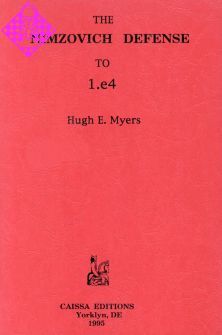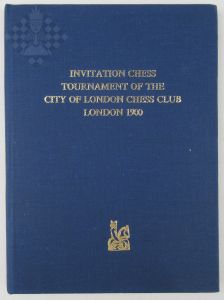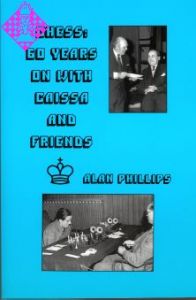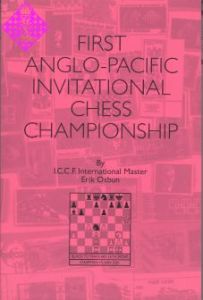Artikelnummer
LOMYENDT1E4
Autor
The Nimzovich Defense to 1.e4
kartoniert, Caissa Editions
Final vergriffen
Introduction:
The most common first move for White is e2-e4. Nb8-c6 is far from being the most popular response to it. That is all to the good if it can be established that 1...Nc6 is a sound defense. Students of the chess openings must give top priority to preparation of their defenses to 1.e4. Their winning chances will be improved if most of their opponents are relatively inexperienced with Black's defense.
In the 1960's I became convinced of the soundness of 1.--Nc6, largely persuaded by games of Aron Nimzovich in his books My System and Chess Praxis. Critics of 1.e4 Nc6 had condemned it simply because Nc6 blocked Black's c-pawn - yet they rthemselves would often defend against 1.e4 with 1.-- e5 2.Nf3 Nc6.
If Black must move his c-pawn, the Knight is not glued to c6. 1.--Nc6 develops a piece, attacks the center, and creates no weaknesses. Options for all pawn moves are retained. Those moves can take Black's game in distinctly different directions (for example e6 plus d5 as compared to d6 plus e5), and they may characterize the defense even more than Nb8-c6. Black has to select his pawn moves with care. Yet they often make up a smaller percentage of the opening moves than they do in other openings. Black's rapid piece development in open variations, or opposite-side castling in the closed ones, can result in attacks on the White King during the early stages of the game. That will usually be an unexpected and unpleasant surprise for a player of 1.e4.
...
The most common first move for White is e2-e4. Nb8-c6 is far from being the most popular response to it. That is all to the good if it can be established that 1...Nc6 is a sound defense. Students of the chess openings must give top priority to preparation of their defenses to 1.e4. Their winning chances will be improved if most of their opponents are relatively inexperienced with Black's defense.
In the 1960's I became convinced of the soundness of 1.--Nc6, largely persuaded by games of Aron Nimzovich in his books My System and Chess Praxis. Critics of 1.e4 Nc6 had condemned it simply because Nc6 blocked Black's c-pawn - yet they rthemselves would often defend against 1.e4 with 1.-- e5 2.Nf3 Nc6.
If Black must move his c-pawn, the Knight is not glued to c6. 1.--Nc6 develops a piece, attacks the center, and creates no weaknesses. Options for all pawn moves are retained. Those moves can take Black's game in distinctly different directions (for example e6 plus d5 as compared to d6 plus e5), and they may characterize the defense even more than Nb8-c6. Black has to select his pawn moves with care. Yet they often make up a smaller percentage of the opening moves than they do in other openings. Black's rapid piece development in open variations, or opposite-side castling in the closed ones, can result in attacks on the White King during the early stages of the game. That will usually be an unexpected and unpleasant surprise for a player of 1.e4.
...
Einleitung:
The most common first move for White is e2-e4. Nb8-c6 is far from being the most popular response to it. That is all to the good if it can be established that 1...Nc6 is a sound defense. Students of the chess openings must give top priority to preparation of their defenses to 1.e4. Their winning chances will be improved if most of their opponents are relatively inexperienced with Black's defense.
In the 1960's I became convinced of the soundness of 1.--Nc6, largely persuaded by games of Aron Nimzovich in his books My System and Chess Praxis. Critics of 1.e4 Nc6 had condemned it simply because Nc6 blocked Black's c-pawn - yet they rthemselves would often defend against 1.e4 with 1.-- e5 2.Nf3 Nc6.
If Black must move his c-pawn, the Knight is not glued to c6. 1.--Nc6 develops a piece, attacks the center, and creates no weaknesses. Options for all pawn moves are retained. Those moves can take Black's game in distinctly different directions (for example e6 plus d5 as compared to d6 plus e5), and they may characterize the defense even more than Nb8-c6. Black has to select his pawn moves with care. Yet they often make up a smaller percentage of the opening moves than they do in other openings. Black's rapid piece development in open variations, or opposite-side castling in the closed ones, can result in attacks on the White King during the early stages of the game. That will usually be an unexpected and unpleasant surprise for a player of 1.e4.
...
Introduction:
The most common first move for White is e2-e4. Nb8-c6 is far from being the most popular response to it. That is all to the good if it can be established that 1...Nc6 is a sound defense. Students of the chess openings must give top priority to preparation of their defenses to 1.e4. Their winning chances will be improved if most of their opponents are relatively inexperienced with Black's defense.
In the 1960's I became convinced of the soundness of 1.--Nc6, largely persuaded by games of Aron Nimzovich in his books My System and Chess Praxis. Critics of 1.e4 Nc6 had condemned it simply because Nc6 blocked Black's c-pawn - yet they rthemselves would often defend against 1.e4 with 1.-- e5 2.Nf3 Nc6.
If Black must move his c-pawn, the Knight is not glued to c6. 1.--Nc6 develops a piece, attacks the center, and creates no weaknesses. Options for all pawn moves are retained. Those moves can take Black's game in distinctly different directions (for example e6 plus d5 as compared to d6 plus e5), and they may characterize the defense even more than Nb8-c6. Black has to select his pawn moves with care. Yet they often make up a smaller percentage of the opening moves than they do in other openings. Black's rapid piece development in open variations, or opposite-side castling in the closed ones, can result in attacks on the White King during the early stages of the game. That will usually be an unexpected and unpleasant surprise for a player of 1.e4.
...
The most common first move for White is e2-e4. Nb8-c6 is far from being the most popular response to it. That is all to the good if it can be established that 1...Nc6 is a sound defense. Students of the chess openings must give top priority to preparation of their defenses to 1.e4. Their winning chances will be improved if most of their opponents are relatively inexperienced with Black's defense.
In the 1960's I became convinced of the soundness of 1.--Nc6, largely persuaded by games of Aron Nimzovich in his books My System and Chess Praxis. Critics of 1.e4 Nc6 had condemned it simply because Nc6 blocked Black's c-pawn - yet they rthemselves would often defend against 1.e4 with 1.-- e5 2.Nf3 Nc6.
If Black must move his c-pawn, the Knight is not glued to c6. 1.--Nc6 develops a piece, attacks the center, and creates no weaknesses. Options for all pawn moves are retained. Those moves can take Black's game in distinctly different directions (for example e6 plus d5 as compared to d6 plus e5), and they may characterize the defense even more than Nb8-c6. Black has to select his pawn moves with care. Yet they often make up a smaller percentage of the opening moves than they do in other openings. Black's rapid piece development in open variations, or opposite-side castling in the closed ones, can result in attacks on the White King during the early stages of the game. That will usually be an unexpected and unpleasant surprise for a player of 1.e4.
...
Introduction:
The most common first move for White is e2-e4. Nb8-c6 is far from being the most popular response to it. That is all to the good if it can be established that 1...Nc6 is a sound defense. Students of the chess openings must give top priority to preparation of their defenses to 1.e4. Their winning chances will be improved if most of their opponents are relatively inexperienced with Black's defense.
In the 1960's I became convinced of the soundness of 1.--Nc6, largely persuaded by games of Aron Nimzovich in his books My System and Chess Praxis. Critics of 1.e4 Nc6 had condemned it simply because Nc6 blocked Black's c-pawn - yet they rthemselves would often defend against 1.e4 with 1.-- e5 2.Nf3 Nc6.
If Black must move his c-pawn, the Knight is not glued to c6. 1.--Nc6 develops a piece, attacks the center, and creates no weaknesses. Options for all pawn moves are retained. Those moves can take Black's game in distinctly different directions (for example e6 plus d5 as compared to d6 plus e5), and they may characterize the defense even more than Nb8-c6. Black has to select his pawn moves with care. Yet they often make up a smaller percentage of the opening moves than they do in other openings. Black's rapid piece development in open variations, or opposite-side castling in the closed ones, can result in attacks on the White King during the early stages of the game. That will usually be an unexpected and unpleasant surprise for a player of 1.e4.
...
| EAN | 0939433222 |
|---|---|
| Hersteller | Caissa Editions |
| Breite | 11,2 cm |
| Höhe | 16,9 cm |
| Medium | Buch |
| Autor | Hugh E. Myers |
| Sprache | Englisch |
| ISBN-10 | 0939433222 |
| Einband | kartoniert |
| Name | Caissa Editions |
|---|---|
| Adresse | 721 Whitebriar Rd. Heckessin, DE 19707 USA |
| dbrandreth3@comcast.net |
Verantwortlicher Importeuer:
| Name | Schachversand Niggemann |
|---|---|
| Adresse | Schadowstraße 5 48163 Münster Deutschland |
| info@schachversand.de | |
| Internet | www.schachversand.de |
001 Chapter 1 (1.e4 Nc6 2.d4 d5 3.e5 Bf5)
A 4.Ne2
B 4.Nf3
C 4.c3
D Other White 4th moves
E Black 3rd moves other than 3...Bf5
020 Chapter 2 (1.e4 Nc6 2.d4 d5 3.exd5 Qxd5)
A 4.Nc3
B 4.Nf3 Bg4
C 4.Nf3 e5
D 4.Be3 e5
033 Chapter 3 (1.e4 Nc6 2.d4 d5 3.Nc3 dxe4)
A 4.d5
B 4.d5 Ne5 5.Qd4 Ng6
C 4.Bb5
D 4.Be3
051 Chapter 4 (1.e4 Nc6 2.d4 d5 3.Nc3)
A 3.Nc3 e5
B 3.Nc3 Nf6 4.e5
C 3.Nc3 a6
058 Chapter 5 (1.e4 Nc6, and 2.-- e6 or 3.--e6)
A 2.d4 e6
B 2.d4 d5 3.e5 e6
C 2.d4 d5 3.Nc3 e6, including 2.Nc3 e6 3.d4 d5
D 2.Nc3 e6, without d7-d5
E 2.Nf3 e6
075 Chapter 6 (1.e4 Nc6 2.Nf3, and moves other than 2.-- e6)
A 2.Nf3 d6 3.d4
B 2.Nf3 g6
C 2.Nf3 d5
D 2.Nf3 Nf6
E 2.Nf3 f5 3.exf5 d5
F 2.Nf3 b6
094 Chapter 7 (2.Nc3, and other White second moves)
A 2.Nc3
B 2.Bc4
C 2.Bb5
D 2.a3
E 2.b3
F 2.c3
G 2.c4
H 2.d3
I 2.g3
J 2.f4
102 Chapter 8 (1.e4 Nc6 2.d4 e5, and other Black second moves)
A 2.d4 e5
B 2.d4 d6
C 2.d4 Nf6
A 4.Ne2
B 4.Nf3
C 4.c3
D Other White 4th moves
E Black 3rd moves other than 3...Bf5
020 Chapter 2 (1.e4 Nc6 2.d4 d5 3.exd5 Qxd5)
A 4.Nc3
B 4.Nf3 Bg4
C 4.Nf3 e5
D 4.Be3 e5
033 Chapter 3 (1.e4 Nc6 2.d4 d5 3.Nc3 dxe4)
A 4.d5
B 4.d5 Ne5 5.Qd4 Ng6
C 4.Bb5
D 4.Be3
051 Chapter 4 (1.e4 Nc6 2.d4 d5 3.Nc3)
A 3.Nc3 e5
B 3.Nc3 Nf6 4.e5
C 3.Nc3 a6
058 Chapter 5 (1.e4 Nc6, and 2.-- e6 or 3.--e6)
A 2.d4 e6
B 2.d4 d5 3.e5 e6
C 2.d4 d5 3.Nc3 e6, including 2.Nc3 e6 3.d4 d5
D 2.Nc3 e6, without d7-d5
E 2.Nf3 e6
075 Chapter 6 (1.e4 Nc6 2.Nf3, and moves other than 2.-- e6)
A 2.Nf3 d6 3.d4
B 2.Nf3 g6
C 2.Nf3 d5
D 2.Nf3 Nf6
E 2.Nf3 f5 3.exf5 d5
F 2.Nf3 b6
094 Chapter 7 (2.Nc3, and other White second moves)
A 2.Nc3
B 2.Bc4
C 2.Bb5
D 2.a3
E 2.b3
F 2.c3
G 2.c4
H 2.d3
I 2.g3
J 2.f4
102 Chapter 8 (1.e4 Nc6 2.d4 e5, and other Black second moves)
A 2.d4 e5
B 2.d4 d6
C 2.d4 Nf6
Mehr von Caissa Editions
-
 First Anglo-Pacific Invitational15,00 €
First Anglo-Pacific Invitational15,00 € -
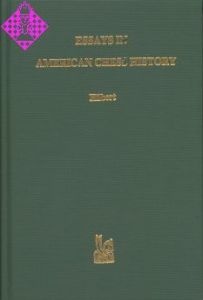 Essays in American Chess History44,95 €
Essays in American Chess History44,95 € -
 New York 194037,95 €
New York 194037,95 € - Mehr von Caissa Editions

